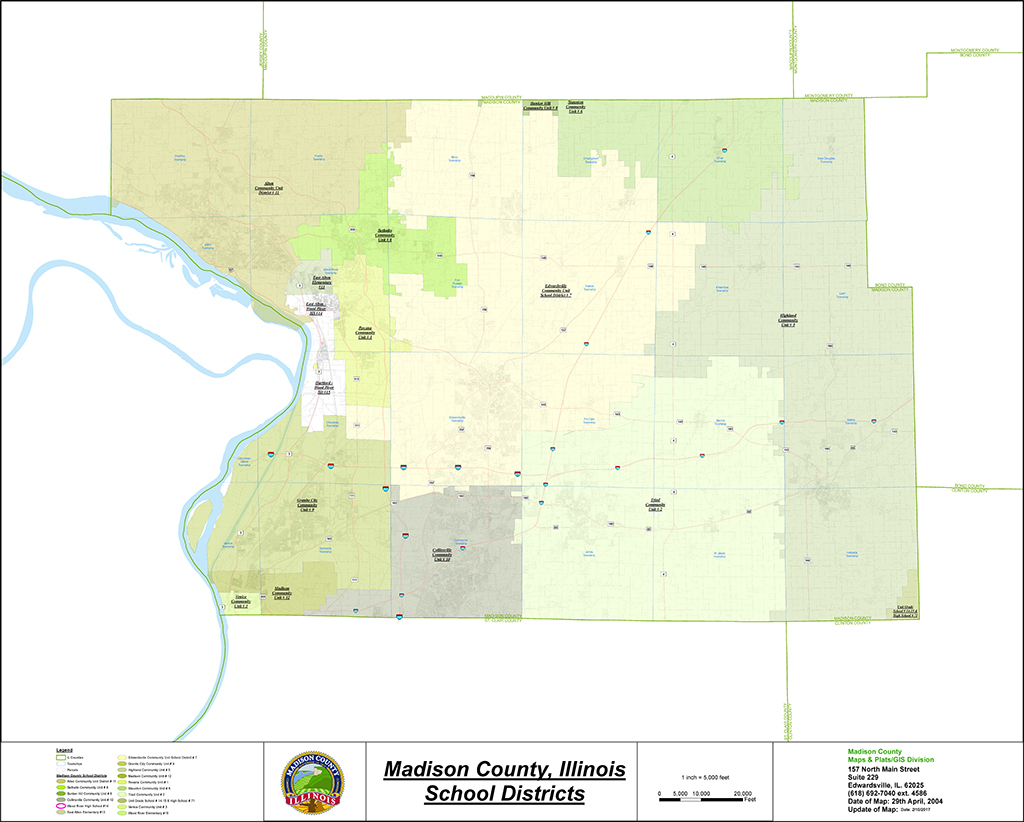School District Consolidation in Madison County
The Madison County school districts began consolidation in the 1940s. By 1947, there were 135 school districts in the county that served 27,838 students and employed 1,063 faculty.((Madison Historical: The Online Encyclopedia and Digital Archive for Madison County, Illinois, “How Madison County School Districts Were Organized,” Madison Historical, accessed March 31, 2017.)) More than half of the 135 schools were one-room districts. In an effort to improve educational opportunities, the Illinois legislature passed a law which provided for the reorganization and, ultimately, consolidation for Illinois and Madison County shools. In House Bill 251, measures were put in place to allow Superintendents of Schools to notify their districts of the potential to consolidate and the process. In larger Illinois districts, such as Chicago, Chairman of the Education Committee and co-sponsor of the bill Lottie Holman O’Neill (1878 – 1967) spoke to more than 300 school board members about the decision to consolidate.((Associated Press, “Morgan Acts to Comply with New School Law,” The Chicago Daily Herald, September 26, 1941.))
Districts in Illinois could reorganize into six types of districts: a community consolidated district, a community unit district, a consolidated district, a consolidated high school district, a charter district, and the common school district.((Madison County Board of Education, “Madison County Board of Education Notes on Types of Districts,” Madison Historical, accessed March 31, 2017.))
For the citizens of Madison County, a seven-person School Survey Committee was appointed in 1945 in response to a directive by the state legislature to determine potential new geographic boundaries for the reorganization and consolidation of schools.((“How Madison County School Districts Were Organized”))
In 1947, Governor Dwight Green (1887 – 1958) signed a law solidifying the criteria for community unit school districts. This was known as House Bill 575.((Illinois House of Representatives, “A Summary of the Community Unit District Law,” Madison Historical, accessed March 31, 2017.)) After holding both public and private meetings, the Madison County School Survey Committee determined that the community unit district would be the most beneficial reorganization and consolidation for the students and staff of Madison County.
In order to petition the state for a community unit district, the intended territory had to contain at least two thousand people. Once approved by a public vote, a community unit district would provide education and bussing to grades one through twelve. It also required a seven-member Board of Education.((Ibid.))
The Committee for Consolidation and Reorganization of Madison County recommended the creation of eleven community unit school districts in their 1947 report to the Illinois State Department of Education.((“How Madison County School Districts Were Organized.”)) The establishment of the community unit district, however, would ultimately be decided upon by a popular vote within the community. As early as 1948, petitions were filed in Madison County with the County Superintendent, who would then organize a public hearing and vote for reorganization and renumeration.
Although community unit districts provided, in essence, a better quality education than a one-room school house or an elementary district, some residents of Madison County were still apprehensive about change in the educational system. The first attempt at generating a community unit school district was in Roxana, which was met with opposition by some of its residents who claimed that the community unit district was a “land-grabbing affair contrived and planned for the advantage of the North Roxana Village and Shell Oil Company.”((Associated Press, “Roxana Area Ponders School Measures,” Alton Evening Telegraph, July 15, 1949.)) However, the Roxana Community Unit District was still consolidated and renumerated in 1949 despite the accusations.((Lesley Thomson-Sasso, “Roxana Community Unit School District #1,” Madison Historical, last modified March 6, 2017.))
Some attempts at reorganization failed, such as the East Alton–Wood River area vote for consolidation in 1973. The last school district to be organized and renumerated was Venice, which became Community Unit District #3 in 1957.((Madison County School Board of Education , “Resolution of Madison County Board of Education Renumerating Venice School District ,” Madison Historical, accessed March 31, 2017.))
Madison County School Districts in 2017
From the Madison County Regional Office of Education
By 1956, the districts that comprise Madison County’s school system were created. In 1968, House Bill 1090 of the Illinois State Legislature created the Department of School District Consolidation to provide consultant services to help consolidated districts provide equal opportunity for quality education standards.((Superintendent of Public Instruction: Ray Price , “Memorandum on Illinois School District Organization from the Superintendent of Public Instruction,” Madison Historical, accessed March 31, 2017.)) Over time, these districts have grown in order to incorporate Madison County’s growing population.
13 school districts are primarily or entirely located in Madison County. They are:
- Alton Community Unit School District #11
- Bethalto Community Unit School District #8
- Collinsville Community Unit School District #10
- East Alton / Wood River School District #14
- East Alton Elementary School District #13
- Edwardsville Community Unit School District #7
- Granite City Community Unit School District #9
- Highland Community Unit School District #5
- Madison Community Unit School District #12
- Roxana Community Unit School District #1
- Triad Community Unit School District #2
- Venice Community Unit School District #3
- Wood River / Hartford Elementary School District #15
Additionally, four school districts primarily located in neighboring counties are partially within the borders of Madison County. They are Bunker Hill Community Unit School District #8, Central Community High School District #71, Staunton Community Unit School District #6, and St. Rose School District #14-15.

